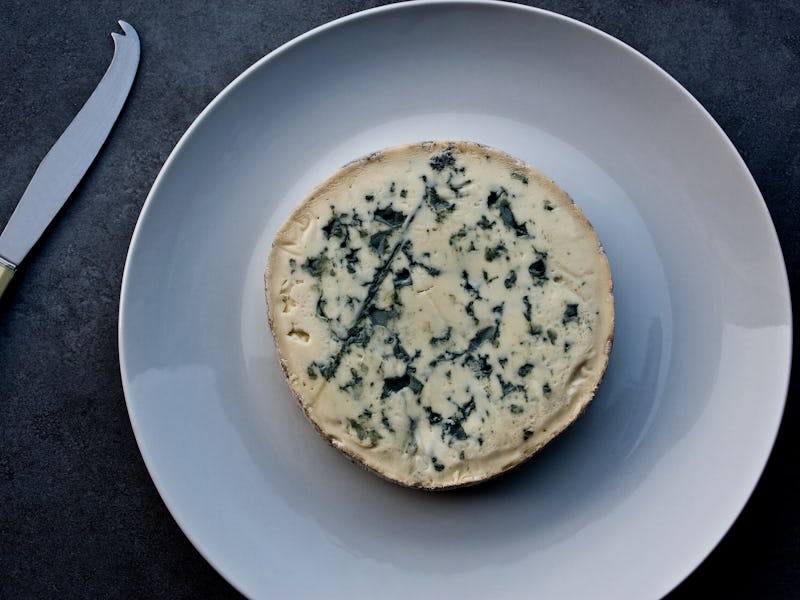What makes mold edible? A food safety expert breaks it down
Sometimes mold is tasty, except when it’s not.

When it comes to delectable fungi, mushrooms get all the attention. Their misunderstood cousin, mold, is cast aside and made the villain, only an indicator of rot in vegetables.
But some mold can be as delicious as hen of the woods or truffles. It’s all a matter of knowing when and where these microscopic fungi are supposed to flourish. Food safety expert at Penn State Extension Martin Bucknavage gets at the good and bad of mold, and how to tell the difference.
Penicillium camemberti creates the earthy rind on soft cheeses like Camembert and Brie.
What kinds of mold are edible?
Some mold is integral to food processing. Blue cheeses like Roquefort, Stilton, and Gorgonzola, as well as soft cheeses like Brie and Camembert, come with some tasty mold. Dry-cured salami boasts mold on its outer casing. In both cases, a species of penicillium mold contribute to both flavor and product viability. And yes, that’s as in penicillin, the antibiotic.
Penicillium roqueforti produces those blue veins and strong stenches in cheese. But it’s penicillium candidum that creates the rigid white rind on Brie cheese.
These are molds that Bucknavage says “belong” on or in these products. They’re part of the manufacturing process and enhance taste and shelf life. “They were put there by the manufacturer, and they have a designated purpose for that product,” he tells Inverse.
For salami, Penicillium nalgiovense is the typical fungus. Once the meat is spiced, cured, and cased, manufacturers cultivate white P. nalgiovense on the surface to seal in taste and ward off other, potentially dangerous molds. The aptly named P. salamii is a relatively new species of edible mold that also grows on cured meat.
Mold on salami has a twofold purpose: to create flavor, and to preserve the meat from moisture.
Which molds are inedible?
Getting away from the penicillium genus, we see the types of mold one generally should avoid. Still, considering there may be tens or hundreds of thousands of mold species, it’s tough to know all of them. Common bad molds on meat and poultry include Alternaria, Aspergillus, Botrytis, Cladosporium, Fusarium, Geotrichum, Monilia, Manoscus, Mortierella, Mucor, Neurospora, Oidium, Oosproa, Rhizopus and Thamnidium. Penicillium, our charcuterie board friend, can also grow on animal products, and in that case, you definitely shouldn’t eat it.
Mold that’s dangerous to consume contains mycotoxins. But, not every kind of inedible mold has mycotoxins. These sickening substances primarily grow in grain and nut products as well as some produce such as apples. Consuming mycotoxins can lead to nausea and vomiting, and at worst, kidney, fetal (if you are pregnant), and immune damage.
Bucknavage emphasizes that mold growing on fruit peels or surfaces definitely doesn’t just stay on the surface. “The mycelium grows into the product,” he says, referring to the growing fungal network. “That’s where some of your toxins are gonna be.”
To prevent bad mold growth, regularly cleaning a fridge and keeping perishables out of warm, humid environments does a great deal of good.
The United States Department of Agriculture (USDA) offers a handy guide on mold, and when to throw out fuzzy foods. And, while Bucknavage says that some mold “belongs” on food, there are instances where moldy fruit sits on a grocery store shelf — and that shouldn't be. Strawberries aren’t meant to be moldy, so it certainly wasn’t put there by anyone on purpose.
Opening a fridge to find mold eating away at produce and bread may be gross and disappointing, but it’s not serious. One ought to beware that mold can also grow in less likely places, like peanut butter jars, cooked pasta (sometimes within the pasta itself), and spreads like jam.
The USDA recommends throwing out this moldy lemon; while it’s growing on the surface, its mycelium roots grow into the fruit.
Can cheese with edible mold grow inedible mold?
Very much yes. Blue and Brie cheeses are just susceptible to growing mycotoxin-containing molds as any other kind of cheese. The species of penicillium growing on it will not, in fact, continue to propagate in your fridge and enrich in flavor. If you see a hunk of fuzzy blue cheese, that fuzz will not enhance its flavor profile.
CHECK, PLEASE is an Inverse series that uses biology, chemistry, and physics to debunk the biggest food myths and assumptions.
Now read this: Why does eating pineapple sting? A food scientist explains the chemistry
This article was originally published on